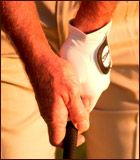October 7, 2020
What's the right grip pressure for you?
 Sam Snead said that he held the club "like he was holding a live bird". This has been the most used axiom that golf teachers have use in describing the grip to beginning golfers for decades. But is it true? No. What is implied is that the gripping of the club should be held lightly. While that is the case for some great players, it definitely is not the case for most modern players and some old time hall-of-famers.
Sam Snead said that he held the club "like he was holding a live bird". This has been the most used axiom that golf teachers have use in describing the grip to beginning golfers for decades. But is it true? No. What is implied is that the gripping of the club should be held lightly. While that is the case for some great players, it definitely is not the case for most modern players and some old time hall-of-famers.
I was fortunate to work for Eric Monti at Hillcrest Country Club in Los Angeles for three years. Eric was an outstanding golfer winning three times on the PGA Tour and finished 6th in the US Open along with five Southern California PGA titles. He did all this while holding a full time job as a head professional. He shared many stories, but one that stands out was a conversation he had with his friend, Ben Hogan. They were discussing the grip and its importance. Hogan was meticulous with how he held the club doing it the same way each time, but the most intriguing statement was how hard he held the club. Hogan told Eric that you couldn't hold the club TIGHT enough. Eric's described his own grip as a "white knuckle grip". You would think that Eric's swing would be a rigid mechanical swing, but it was the exact opposite. His swing was fast, but very rhythmical. He griped his wedge shots the same way, but his touch was outstanding.
When I was 16 years old, I was lucky to sit ten feet away from Arnold Palmer as he practiced for a full hour at the LA Open at Rancho Park. I was so impressed with the consistency of his shots throughout his bag and the solid sound that he made with each iron shot. Arnold had big hands and large forearms. His hands looked like they engulfed the grip and appeared like a vise. There was definite tension in the forearms, but all else was smooth and flowing. Jack Nicklaus hands are smaller, so the appearance of his hands on the club had a different look. But Jack has stated that he gripped the club on the firm side. Gary Player was also a firm gripper of the club.
Today's golfers are more athletic and do weight training to add strength and speed. Bryson DeChambeau has taken this regiment to its extreme. You see tension throughout his body and especially in his hands. He has done this to increase his clubhead speed to get more distance. It certainly has worked.
Golfers like Bobby Jones, Gene Sarazen, Julius Boros, Sam Snead, Ben Crenshaw, Freddie Couples, Louie Oosthuizen, Rickie Fowler, and Shane Lowry are some of the players that would be considered "hands and arm" swingers. The modern swing is more "legs and body". It is true that all swings are a combination of the whole body, but certain elements contribute more to produce power and consistency. Byron Nelson was one of the first to emphases this "legs and body" motion, with Jack Nicklaus the classic example for the mid-70's. Now most of the top ranked golfers in the world have body oriented swings. "Hands and arm" swingers tend to hold the club lighter. That is not to say loosely or else the club would fly out of their hands. They hold it tight enough so there is no "play" or club wiggle when the club strikes the ball. The "legs and body" players are inclined to hold the club tighter, because there is more hit or shock to their strike of the ball and that requires no deviation in the transfer of energy through the hands to the club.
So what is the right grip pressure for you? The right pressure should be hard enough so there is no energy loss through the hitting of the ball while maintaining supple free flowing wrists, arms, and shoulder swinging motion. If you grip too hard the usual result is tension in the whole body and that will slow the swing down considerably. The long drivers strive for a faster clubhead speed. For the average player that does not produce clubhead speed over 90 mph, a death grip will not produce the results you want. Players like Bryson and those that you see in National Driving contests that drive the ball over 400 yards, they have trained their muscles to be tight, strong, but most important, flexible. They need a vise like grip to stay firm when their driver strikes the ball at 130 mph.
My suggestion for you is to experiment with different grip pressures. Grip the club as tight as you can and see the result. Then try different degrees of tension down to barely holding on. Be aware of the feeling of your body, especially the shoulders, arms, and wrists. Write down the distance with each grip pressure. You might find the looser grip will generate greater speed and distance, but not consistency. Then a little firmer grip would be better. Your hands are the only contact you have with the golf club, the grip should be exact each time you place your hands on the club. The grip pressure should be equal throughout the swing with no loosening or tightening during the swing. Each person has a grip pressure that works best for them, but it must be tested and experimented to find the right combination.



